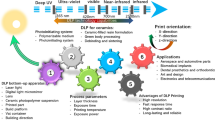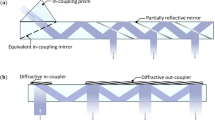Abstract
Shape reconstruction using structured light has become one of the most widely used optical 3D scanning methods, especially in the field of reverse engineering. Longitudinal resolution is a main parameter in a shape reconstruction technique. An experimental assessment technique is proposed to evaluate the longitudinal resolution of a structured light measurement system. The proposed approach is based on incrementally moving a flat board, and reconstructing its shape at each position. The phase shift between the board wavefront at each position and the reference position wavefront is evaluated. The unwrapped phase is then used to evaluate the smallest board movement detectable by the measurement system. Taguchi method and ANOVA test are used to investigate the effect of various measurement system parameters on the estimated resolution.
Similar content being viewed by others
Abbreviations
- L:
-
The normal distance between the camera and a reference plane
- D:
-
the distance between the centres of lenses of camera and projector
- f:
-
frequency of the fringe pattern projected
- ϕ :
-
The phase shift between the reference wavefront and the object wavefront
References
Gdeisat, M. A., Burton, D. R., and Lalor, M. J., “Eliminating the Zero Spectrum in Fourier Transform Profilometry using a Two-Dimensional Continuous Wavelet Transform,” Optics Communications, Vol. 266, No. 2, pp. 482–489, 2006.
Abdul-Rahman, H., “Three-Dimensional Fourier Fringe Analysis and Phase Unwrapping,” Ph.D. Thesis, General Engineering Research Institute, Liverpool John Moores University, 2007.
Zhang, S., “Recent Progresses on Real-Time 3D Shape Measurement using Digital Fringe Projection Techniques,” Optics and Lasers in Engineering, Vol. 48, No. 2, pp. 149–158, 2010.
Abbas, K., “A New Recurrent Approach for Phase Unwrapping,” International Journal of Applied Science and Engineering, Vol. 3, No. 2, pp. 135–143, 2005.
Karout, S., “Two-Dimensional Phase Unwrapping,” Ph.D. Thesis, General Engineering Research Institute, Liverpool John Moores University, 2007.
Audet, S. and Okutomi, M., “A User-Friendly Method to Geometrically Calibrate Projector-Camera Systems,” Proc. of IEEE Computer Society Conference on Computer Vision and Pattern Recognition Workshops, pp. 47–54, 2009.
Yamazaki, S., Mochimaru, M., and Kanade, T., “Simultaneous Self-Calibration of a Projector and a Camera using Structured Light,” Proc. of IEEE Computer Society Conference on Computer Vision and Pattern Recognition Workshops (CVPRW), pp. 60–67, 2011.
Xiaoling, Z., Yuchi, L., Meirong, Z., Xiaobing, N., and Yinguo, H., “Calibration of a Fringe Projection Profilometry System using Virtual Phase Calibrating Model Planes,” Journal of Optics A: Pure and Applied Optics, Vol. 7, No. 4, pp. 192–197, 2005.
Kemao, Q., Wang, H., Gao, W., Feng, L., and Soon, S. H., “Phase Extraction from Arbitrary Phase-Shifted Fringe Patterns with Noise Suppression,” Optics and Lasers in Engineering, Vol. 48, No. 6, pp. 684–689, 2010.
Horn, E. and Kiryati, N., “Toward Optimal Structured Light Patterns,” Image and Vision Computing, Vol. 17, No. 2, pp. 87–97, 1999.
Georgopoulos, A., Ioannidis, C., and Valanis, A., “Assessing the Performance of a Structured Light Scanner, International Archives of Photogrammetry,” Remote Sensing and Spatial Information Sciences, Vol. 38, No. 5, pp. 250–255, 2010.
Li, Y. F. and Chen, S. Y., “Automatic Recalibration of an Active Structured Light Vision System,” IEEE Transactions on Robotics and Automation, Vol. 19, No. 2, pp. 259–268, 2003.
Chen, C. H. and Kak, A. C., “Modeling and Calibration of a Structured Light Scanner for 3-D Robot Vision,” Proc. of IEEE International Conference on Robotics and Automation, Vol. 4, pp. 807–815, 1987.
Sansoni, G., Carocci, M., and Rodella, R., “Calibration and Performance Evaluation of a 3-D Imaging Sensor based on the Projection of Structured Light,” IEEE Transactions on Instrumentation and Measurement, Vol. 49, No. 3, pp. 628–636, 2000.
Takeda, M. and Mutoh, K., “Fourier Transform Profilometry for the Automatic Measurement of 3-D Object Shapes,” Applied Optics, Vol. 22, No. 24, pp. 3977–3982, 1983.
Ranjit, R., “A Primer on the Taguchi Method,” van Nostrand Reinhold, Chap. 6, Section 6.6.1, p. 124, 1990.
Author information
Authors and Affiliations
Corresponding author
Rights and permissions
About this article
Cite this article
Mahmoud, D., Khali, A. & Younes, M. Optimization of the longitudinal resolution of a structured light shape reconstruction system, a DOE approach. Int. J. Precis. Eng. Manuf. 16, 1935–1939 (2015). https://doi.org/10.1007/s12541-015-0251-6
Received:
Revised:
Accepted:
Published:
Issue Date:
DOI: https://doi.org/10.1007/s12541-015-0251-6




